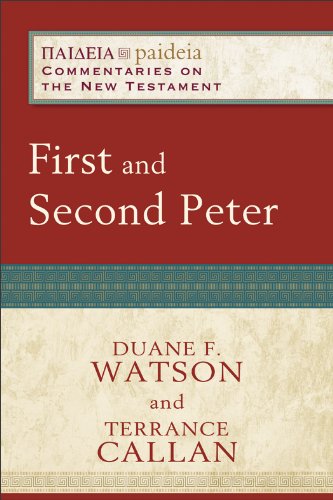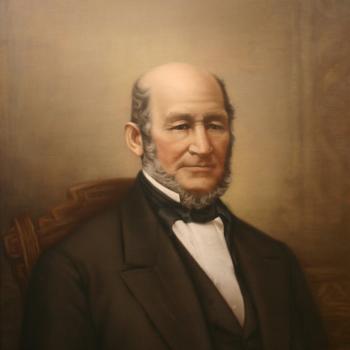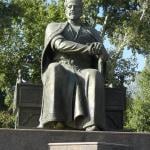 The relatively new commentary series from Baker Academic called “Paideia” is continuing to release New Testament volumes at a steady rate. Some of the best volumes to date include Charles Talbert’s work on Colossians/Ephesians as well as Frank Matera on Romans. Recently, Duane Watson and Terrance Callan published (in one volume) on 1-2 Peter.
The relatively new commentary series from Baker Academic called “Paideia” is continuing to release New Testament volumes at a steady rate. Some of the best volumes to date include Charles Talbert’s work on Colossians/Ephesians as well as Frank Matera on Romans. Recently, Duane Watson and Terrance Callan published (in one volume) on 1-2 Peter.
By way of reminder, the Paideia series focuses on the final form of the text and draws attention to cultural, literary, and theological dimensions of the book. This is not a technical series (like Hermeneia, NIGTC, or AB), but one for students who want an accessible guide to a NT text. The commentaries don’t work from verse to verse, but section by section.
1 Peter
Duane Watson is responsible for 1 Peter. In his introduction he questions those that argue for pseudepigraphy. Perhaps the strongest argument against Peter writing this letter is the high level of Greek demonstrated in the text. Watson counter-argues: “Peter had spend nearly three decades preaching to Greek-speaking audiences, which surely improved his skill in Greek.” When it comes to use of the LXX, Watson presumes the historical Peter would have also developed familiarity with it over time. He deconstructs a host of arguments against Petrine authorship and, ultimately, finds enough plausibility it was Peter to assume so much in the commentary (5). Thus, he dates 1 Peter to about 80AD. Why did Peter write this letter?
In light of this situation [of local, unofficial persecution], the letter is written to encourage the recipients (5:12) and give their suffering theological purpose as a vital part of the Christian life, especially as a testing from God (4:12, 19) and an imitation of Christ (2:21-23; 3:18). It stresses that good conduct is the best way to quell verbal and physical abuse instigated by hostile gentile neighbors and authorities (2:12-17; 3:13-17), as well as an outworking of their new holy nature as obedient children of God (1:14-16).” (9)
The introduction is rounded out by a nice section on the theology of 1 Peter which includes a discussion of topics such as the doctrine of God, Christology/Soteriology, Ethics, Pneumatology, and Eschatology.
When it comes to Watson’s commentary notes, there is no need to discuss them in detail. We can say that Watson offers a competent, well-researched (though all-t00-brief) guide to 1 Peter. I will just mention a few texts.
1:9: “salvation of your souls.” Watson: “The soul is not the soul in distinction from the body, to be rescued from imprisonment in the body at death, as in much Greek thought, but a person’s essence or self-identity, as in OT thought” (27). Right!
1:13: “gird up the loins of your mind.” Watson makes the argument that, because “your” is plural in Greek and “mind” is singular, Peter is particularly calling the readers to “work as a corporate body rather than rallying each member to his or her own individual effort” (32). This is a nice sentiment, but hardly a foregone conclusion syntactically. This would be an example of the “distributive genitive” where it means “mind of each of you.” Think about LXX Lev 19:27 where it is forbidden that any male should shave “the beard (s) of you (pl).” This is NOT referring to their national collective beard (!), but simply each person’s beard.
2:1-2: Is the vice list here “conventional” or “contextual”? Watson is open to either, but gives a good consideration that it is, in fact, directed towards the readers in their particular situation (43). I think this is a worthy consideration.
4:6: “For this reason the gospel was preached even to the dead.” This has long been a perplexing passage, but I think Watson makes a good case that “Most likely the dead are a portion of all the dead mentioned in verse 5. They are the Christians who had the gospel preached to them, but have since died.” (99).
2 Peter
Callan writes on 2 Peter and takes this text to be pseudonymous. He bases his view largely on the “testamentary character” of 2 Peter. He also points to problems regarding vocabulary and style. Later on, he tries to help readers alleviate any moral dilemma by suggesting that if 2 Peter was read as a “testament,” the first readers would have presumed Peter did not write it (165-66). I am not sure this is as convincing as Callan thinks. I think that there are simply too many versimilitudes (features that identify the author with Peter and his experiences) to conclude that it would have been a no-brainer this was NOT Peter.
Now, while 1 Peter and 2 Peter are very different texts, I was a bit struck by Callan’s appeal to vocabulary and style issues as pertinent contributions to the case for pseudonymity when Watson had effectively “de-bunked” these issues vis-a-vis 1 Peter. In many ways, the truth is in the eye of the beholder and this appears to be an ongoing challenge for interpreters – can we come to an agreement about what kinds of “problems” are serious and which ones are not?
In some of his earlier statements in the commentary, Callan raises the question, is 2 Peter representative of “early Catholicism”? He notes Bauckham’s identification features for EC: (1) fading hope of Christ’s Parousia, (2) increasing institutionalization, and (3) crystallization of the faith into set forms. Callan, following Bauckham’s perspective, concludes that, if these are the criteria, then 2 Peter is quite clearly not representative of “early Catholicism.” (164-165). I think this is right.
As for the commentary notes, I will not give any examples, but overall the comments are reliable and often insightful.
Overall
Especially because there has not been much attention paid to the Catholic Epistles in NT scholarship until relatively recently in history, I am happy to see this volume on 1-2 Peter. Nothing really earth-shattering is argued by either of the authors (Watson and Callan), but that is not really the purpose of the series. The Paideia series aims to teach students the critical issues involved in the text, the general thrust of the text, and the theological significance of the text. No doubt we find an extremely competent volume that accomplishes these aims admirably.















